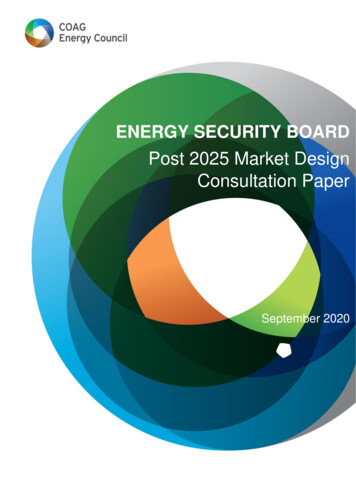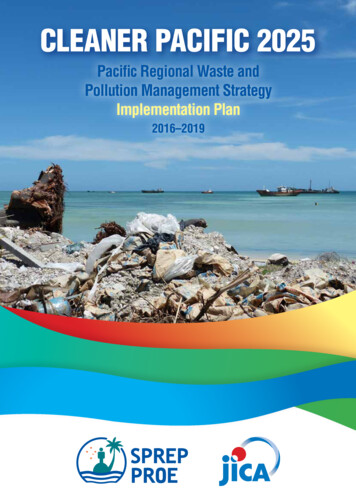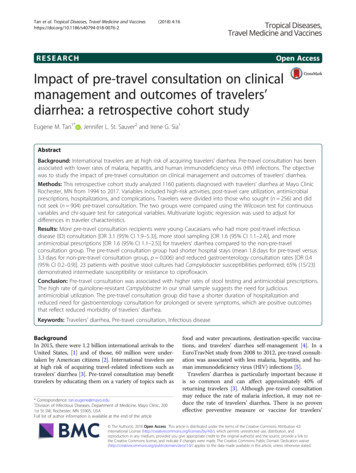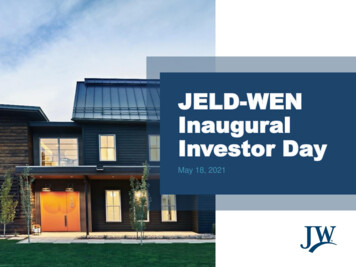
Transcription
ENERGY SECURITY BOARDPost 2025 Market DesignConsultation PaperSeptember 20201
Dr Kerry Schott AOIndependent ChairEnergy Security BoardDavid SwiftIndependent Deputy ChairEnergy Security BoardClare SavageChairAustralian Energy RegulatorMerryn YorkChair (Acting)Australian Energy Market CommissionAudrey ZibelmanCEO and Managing DirectorAustralian Energy Market Operator2
CONTENTSCONTENTS . 3EXECUTIVE SUMMARY . 71.2.3.4.5.6.7.INTRODUCTION. 131.1.Background . 131.2.Consultation and submissions . 14THE EXISTING NEM DESIGN AND ITS CHALLENGES . 152.1.Meeting consumer needs . 162.2.Managing variability and uncertainty . 182.3.Need for capital replacement . 192.4.Need to value demand flexibility and integrate DER . 22MARKET DESIGN INITIATIVES . 263.1.Development of market design initiatives . 263.2.Transition period . 273.3.Relationship to other initiatives . 28RESOURCE ADEQUACY MECHANISMS – MARKET DESIGN INITIATIVE A. 294.1.What is the problem this initiative is addressing? . 294.2.What are the options considered? . 364.3.Which options are proposed for further development and consideration? . 444.4.Questions for consultation . 46AGEING THERMAL GENERATION STRATEGY – MARKET DESIGN INITIATIVE B . 475.1.What is the problem this initiative is addressing? . 475.2.What are the options for addressing these risks? . 545.3.What are we proposing to do next? . 585.4.Questions for stakeholders . 58ESSENTIAL SYSTEM SERVICES – MARKET DESIGN INITIATIVE C . 596.1.What is the problem this initiative is addressing? . 596.2.What are the options considered? . 606.3.Which options are proposed for further development and consideration? . 716.4.Regulatory framework changes . 726.5.Questions for stakeholders . 73SCHEDULING AND AHEAD MECHANISMS – MARKET DESIGN INITIATIVE D . 747.1.What is the problem this initiative is addressing? . 747.2.What are the options considered? . 793
8.9.7.3.Which options are proposed for further development and consideration? . 847.4.Questions for stakeholders . 85TWO-SIDED MARKETS – MARKET DESIGN INITIATIVE E . 868.1.What is the problem this initiative is addressing? . 868.2.What are the options considered? . 888.3.Questions for stakeholders . 95VALUING DEMAND FLEXIBILITY AND INTEGRATING DER – MARKET DESIGNINITIATIVE F . 969.1.What is the problem this initiative is addressing? . 969.2.What are the options considered? . 989.3.Which options are proposed for further development and consideration? . 1079.4.Questions for stakeholders . 10710. TRANSMISSION ACCESS AND THE COORDINATION OF GENERATION ANDTRANSMISSION – MARKET DESIGN INITIATIVE G. 10810.1.What is the problem this initiative is addressing? . 10810.2.What are the options considered? . 11210.3.Questions for stakeholders . 11511. OVERALL MARKET DESIGN – INTERDEPENDENCIES AND EVALUATION. 11611.1.Interdependencies between initiatives. 11611.2.Evaluation approach . 11712. ENGAGEMENT WITH STAKEHOLDERS . 11912.1.Consultation process and submissions . 120Appendix – Evaluation framework . 121Appendix – Summary of Questions for stakeholders . 125TablesTable 1Table 2Table 3Table 4Table 5Table 6Table 7Post-2025 market design initiatives . 26Factors that can deter investment . 32Operating reserve mechanism. 39Initial consideration of residual risks . 57Ahead mechanism design options. 80Stage One – workstream level assessment criteria . 122Stage Two – reform-wide assessment principles. 1234
FiguresFigure 1Figure 2Figure 3Figure 4Figure 5Figure 6Figure 7Figure 8Figure 9Figure 10Figure 11Figure 12Figure 13Figure 14Figure 15Figure 16Figure 17Figure 18Figure 19Figure 20Figure 21Figure 22Figure 23Figure 24Figure 25Figure 26Figure 27Figure 28Figure 29Figure 30Figure 31Figure 32Figure 33Figure 34Figure 35Figure 36Figure 37Phased market development – a representative example . 11Post-2025 program key deliverables . 14ECA Energy Consumer Sentiment Survey – 'How confident are you that the overallmarket is working in your long-term interests’ (% scoring 7 or higher out of 10). 16Penetration of variable renewable energy resources is increasing . 18Instantaneous penetration of wind and solar generation, actual in 2019 and forecastfor 2025 under ISP Central and Step Change generation build scenarios . 19Thermal synchronous generation exiting the NEM . 20Installed wind and solar capacity in the NEM for 2019, with 2025 and 2040 forecastsfrom final 2020 ISP Central and Step Change generation build scenarios . 21Poll of leading debt and equity investors in Australia regarding the challenges facinginvestors in large-scale renewable energy . 22Effect on South Australian operational demand from increasing distributed PVgeneration (10 November 2019) . 23Minimum operational demand projections for South Australia . 24Coal-fired and gas-powered generation retirements . 49Impacts on price and reliability with different numbers of units exiting – stylisedexample . 51Wholesale prices following the exit of Hazelwood Power Station. 52New generation and storage technologies reduce price cycles . 53Relevant reliability measures in the sudden exit scenario . 55procurement options for Essential System Services (with identification of currentprovision mechanisms for services in bold) . 61An illustrative demand curve for an essential system service . 63Initial assessment of market design characteristics of Operating Reserves . 64Percentage of dispatch intervals during which Contingency FCAS prices exceeded 25/MWh, September 2019 to June 2020 . 65Initial assessment of the market design characteristics of frequency control . 67Initial assessment of the market design characteristics of inertia . 68Initial assessment of market design characteristics of system strength . 70A possible roadmap of procurement and scheduling options for essential systemservices . 72Possible checks and balances of regulatory oversight, allowing regulatoryadaptability .73Actual less Residual Demand forecasts (MW) approaching real time for Victoria(2011-20) . 77Actual less Forecast Prices ( MWh) approaching real time for Victoria (2011-20) . 77The Current Directions process and UCS . 81NEM-wide demand by time of day 2019-20 . 87NEM-wide price by time of day (weighted by demand) 2019-20 . 87benefits of participation from price elastic demand and supply . 90Small scale solar installations by size in kW since Jan 2007 . 97Solar PV and battery storage forecast . 98Overview of DER interactions and supporting architecture along the supply chain . 102Installed capacity by year (ISP central scenario) . 109Instances of congestion in the NEM 2013-19. 111Phased market development . 117Overview of Post-2025 program evaluation framework . 1215
LIST OF CMT PASANEMNEONSPPSSASPVRAMsRERTRIT-TRoCoFRROST PASATOUTNSPUCSVPPVREWDRMAustralian Competition and Consumer CommissionAustralian Energy CouncilAustralian Energy Market CommissionAustralian Energy Market OperatorAustralian Energy RegulatorAustralian Renewable Energy Agencycommercial and industrialCouncil of Australian GovernmentsCommonwealth Scientific and Industrial Research OrganisationDistributed Energy Integration Programdistributed energy resourcesEnergy Adequacy Assessment ProjectionEnergy Consumers AustraliaEnergy Networks AustraliaEnergy Security BoardEssential System ServicesElectricity Statement of Opportunitieselectric vehiclefrequency control ancillary servicesfast frequency responseGigawattinverter based resourcesIntegrated System PlanMarket Design Initiativemarginal loss factorMarket Price CapMedium Term Projected Assessment of System AdequacyNational Electricity MarketNational Electricity ObjectiveNetwork Service ProviderPower System Security Ancillary ServicesPhotovoltaicResource Adequacy MechanismsReliability and Emergency Reserve TraderRegulatory Investment Test – Transmissionrate of change of frequencyRetailer Reliability ObligationShort Term Projected Assessment of System AdequacyTime of UseTransmission Network Service ProviderUnit Commitment for SecurityVirtual Power Plantvariable renewable energyWholesale demand response mechanism6
EXECUTIVE SUMMARYWhy the market design needs to changeThe energy system is changing. New technology and digitalisation are providing new choices andopportunities to customers. At the same time, the rapid uptake of Variable Renewable Energy(VRE) and Distributed Energy Resources (DER) is well underway and the existing ageing thermalgeneration fleet is progressively retiring. The National Electricity Market (NEM) of the future isvery different to that of the past.Similar changes are occurring in many electricity markets across the world. But the rapid paceof change occurring in Australia and the adoption of distributed (rooftop) solar photovoltaic (PV)systems is remarkable. At least 2.2 million households now have solar PV on their rooftops, upfrom 100,000 a decade ago. This means the changes to the NEM design are likely to be amongthe first in the world to meet these needs.All the changes occurring mean that the current set of systems, tools, market arrangements andregulatory frameworks is no longer entirely fit for purpose and able to meet the changing needs ofthe system and customers. To address these matters, the Energy Security Board (ESB) is taskedby the former COAG Energy Council to develop a market design for the NEM that delivers secureand reliable power at least cost to consumers, and accommodates the changes underway andexpected in the future. This paper sets out for consultation a number of potential solutions toidentified problems and opportunities.Overview of workstreams within Post-2025 market design programTo deliver future market designs, the ESB set up seven workstreams to consider the issues anddevelop potential solutions. The initial work has been done by the market bodies the AustralianEnergy Market Commission (AEMC), Australian Energy Market Operator (AEMO) and AustralianEnergy Regulator (AER) working together with ESB staff. Industry and consumer groups andother stakeholders have been involved and consulted along the way. The outputs from each ofthe individual workstreams have inter-relationships and need to be considered together for acoherent whole design.The seven workstreams are: Resource adequacy mechanisms (RAMs). Ageing thermal generation strategy. Essential system services. Scheduling and ahead mechanisms. Two sided markets. Valuing demand flexibility and integrating DER. Transmission access and the coordination of generation and transmission investment.Resource adequacy mechanisms (RAMs)While the system requirements change over the next 10-15 years, the issue is whether existingmechanisms are sufficient to support the needs of the system, or whether other complementarymeasures are needed. In particular, are existing mechanisms sufficient to support the requirednew investments?7
A complex mix of resources is required to deliver electricity at the lowest overall cost tocustomers. The mix includes energy from thermal and renewable sources, flexible supply anddemand response resources, and energy storage of different types1.Ensuring there is sufficient and timely investment in this mix of resources is critical to delivering asecure, reliable and affordable supply of electricity. If private sector balance sheets are to fundthis significant new investment at least cost, then there will need to be a degree of confidenceover future prices and the role of government in the market.The ESB is considering various options for how investment signals could be improved. First arethose mechanisms that would strengthen the current real-time price signals for investment thatshould then flow through to expectations about future sustained high prices. Second are thosemechanisms that introduce a longer duration price signal for investment, either through aseparate mechanism or through longer duration contracting. The ESB invites views on whether the current resource adequacy mechanisms in the NEMare sufficient to drive investment in the quantity and mix of resources required through thetransition. The ESB is considering the merits of a spectrum of options intended to strengthen signals forinvestment and support the reliability and security needs of the system. Feedback is sought on how governments could best leverage the long term investmentsignals in the NEM to reflect their jurisdictional policy priorities.Ageing thermal generation strategyWith 61% of the existing thermal generation resources in the NEM likely to exit over the next twodecades, it is essential for reliability of supply and affordability of electricity prices that thistransition is efficient, and delivered at least cost to customers.Uncertainty around the timing of exit of ageing thermal generators could have a significant impacton the affordability of electricity. This uncertainty could result in replacement capacity beingdelayed or new investments requiring a higher return on capital. This could lead to higherelectricity prices. This uncertainty is also reflected in the level of transmission investment requiredunder the Integrated System Plan (ISP).Premature exit of ageing thermal generation can also increase the risk to security, reliability andaffordability of electricity supply, as replacement capacity may not be available to ensureresource adequacy and electricity prices may be higher than necessary, allowing existinggeneration to attract additional rents.There are a number of measures that would reduce the uncertainty around the timing of exit ofageing thermal generation and the risk of premature generation plant exit. These includemeasures to ensure that essential system services are available, the 42-month notice of closurerule, and Retail Reliability Obligations that may be triggered. The ESB will consider whether thereare additional measures needed during the transition period as thermal generators retire.1 The priority of this workstream is to meet the needs of the transition at least cost toconsumers. The ESB is seeking feedback on the likely effectiveness of current arrangements to minimiseconsumer costs and manage risks to reliability and security over the transition (including theirmateriality) and whether additional measures may be needed for the transition, taking intoaccount other changes to the market design proposed through this work.See AEMO 2020 Integrated System Plan ystem-plan-isp8
Essential system servicesAs more renewables come into the system, providing lower cost energy, there is a need toupdate how other essential services are provided. These essential services keep the system in asecure and reliable operating state and become increasingly important as older thermalgenerators retire. Many of the attributes and capabilities provided intrinsically by the ageingthermal generation fleet are not intrinsic to inverter based renewable technologies and must besourced and procured by other means.This work to define the necessary capabilities and characteristics for new services, and toconsider options about how best to procure these services, is vital for the system to be bothsecure and affordable. It will set foundations for the future NEM. Effective market signals areneeded to achieve short term operational goals and support longer term investment decisions todeliver a secure system and drive down costs to consumers. A framework is set out to enable the market to progress to more sophisticated ways todeliver system services as the system changes, and as technology and market conditionsallow. Feedback is sought on procurement mechanisms and market arrangements for a range ofservices including an operating reserve spot market, fast frequency response as a frequencycontrol ancillary services (FCAS) style spot market (from assets like batteries), structuredprocurement for synchronous generation commitment (for system strength and inertia)potentially combined with an ahead mechanism, with support for further longer termconsideration for an inertia spot market.Scheduling and ahead mechanismsIn 2025, the system will be more complex, and variable and changing patterns of demand andsupply create challenges in keeping the system balanced. This can lead to costs for consumers(for example through AEMO directions) that could be avoided by better market design. Gettinggreater visibility of the resources available in the system supports the ability to achieve real timeeconomic dispatch of the system and reduces reliance on operator intervention into the market toassure system security and reliability.Changes to market arrangements are considered that introduce greater visibility and certainty ofresources on the system ahead of real time. The proposed changes also provide greateropportunity for DER (including demand) to participate and support lower operating costs andinvestment requirements. A spectrum of options is set out. These are intended to introduce greater visibility andcertainty of resources ahead of real time. Options for development include a voluntary ahead market to procure and/or trade relevantsystem services (with or without energy) with a financial commitment. Options to introduce acompulsory ahead market design are not intended to progress.Two sided marketsThere is potential for customers, including owners of DER, to participate actively in future marketsand unlock value from their flexibility. Making demand more flexible can support lower investmentrequirements and create operational efficiencies that benefit all consumers. Where they chooseto do so, individual customers can partner with retailers or third party providers to exchange theirload flexibility for cheaper overall supply and potentially contribute to system security services.These options are already emerging (e.g. load shaping offers using pool pumps and hot watersystems). As transport systems and other elements of our economy electrify, two sided marketshelp ensure the system is capable of taking advantage of these changes for the net economicbenefit of consumers.9
Getting the market framework right is the key to accommodating different customer needs andensuring appropriate consumer protections are provided for families and businesses. The intention of a progressive shift to a two sided market is to better reward the valueprovided to the system of flexible demand and supply. Reforms are focused on facilitating new types of participation in the market, enabling greaterinnovation and choice to customers, and on working out how to best incorporate priceresponsive supply and demand into real time dispatch and forecasting processes. Engagement with consumer stakeholders is important to ensure two sided marketarrangements are designed in a manner that is not overly complex and that maximisesparticipation from a broad range of customers (in partnership with retailers and other serviceproviders). Adjustments to the consumer protections framework will be needed to make sure consumershave fit-for-purpose protections that reflect new ways of engaging with energy servicesproviders.Valuing demand flexibility and integrating DERTo ensure we maximise the value for all consumers of DER there is a need for technical,regulatory and market arrangements to support their effective integration. A lot of resources havealready entered the system, but efforts to coordinate and effectively integrate these resources (torealise their potential value) must quickly catch up.The value of these resources, and their potential flexibility, is increasing. Electricity marketarrangements do not currently make it easy for new and different types of service providers toparticipate. Arrangements that facilitate innovative new business models and integrate newtechnologies in the system are needed in ways that are fair for all. The priority for the post-2025 program is to integrate DER into the market, including therange of design changes we canvass throughout this report. Reforms will seek to provide opportunities for DER to participate where possible and efficient– making it easier for DER to provide services into all markets, and for owners to get valuefor their investments.Transmission access and the coordination of generation and transmission investmentThe shift to locate generation in different places is a challenge for the existing transmissionnetwork, connections to it, and how it is accessed and used. We need arrangements that canefficiently manage congestion on the grid and get renewable power to consumers by making sureinvestment can happen in the right places (e.g. signals to encourage new generation into REZsor to have big batteries located where the system needs them most). A combination of regulatoryand market arrangements are needed to support efficient and timely investment to deliverefficient outcomes to customers and investors. The reforms for transmission access will include interim measures to address currentcongestion as well as frameworks to support efficient and timely investment over the longerterm. Work is focused on how best to introduce progressive and proportionate reforms totransmission access, that deliver benefits to consumers and support an overall coherentmarket design.Developing a coherent package of reformsOne of the biggest value adds of the post-2025 reform program is the ability to map out acoherent long term reform path.10
Ordinarily, incremental changes are considered on an individual basis, and this may notbe the best way to consider a whole of market redesign. The value of considering a broaderprogram of reform enables a systems thinking approach to be taken, so design elements can beoptimised together. This also means it is important the evaluation process carefully considershow the different program elements work together, to limit the risk of unintended consequencesas far as possible.Once a package of reforms has been agreed, progressive implementation of the potential reformswill reduce the risk of unintended consequences. The high-level plan beyond 2025 sets out wheremore sophisticated tools, systems and arrangements may be needed to address the strategicchallenges facing the NEM as these evolve over the next 10-15 years.This work has already started with work to action the ISP, develop interim system security andreliability measures and introduce Renewable Energy Zones (REZs) now in place or underway.While some early and interim measures are being delivered to address needs already emergingwithin the system, a progressive approach for delivering initiatives enables the impacts of eachset of measures to be felt before building further on these with additional reforms. This approachalso enables a continued focus on delivering changes needed to support the transition at leastcost to consumers.A representative example showing at a high level how the post-2025 reforms could build on earlymeasures taken is illustrated below. While the measures represented here are not arecommended option, depicting them over these horizons shows the potential to build on thechanges made in each phase. This figure represents the measures highlighted in this paper andhow a progressive implementation for reforms may proceed. By introducing a suite of measuresprogressively, there is scope to gain better insights about how each set of measures may, incombination, work to address the evolving challenges and unlock other opportunities. The risk oflayering multiple solutions onto problems is reduced.The congruency of reforms over the short and medium term through to longer term horizonsneeds to be evaluated. Reforms that are likely to be required and delivered over those periodscan be considered together, enabling an assessment of how the combined changes impactconsumers, the market and system. This approach
for 2025 under ISP Central and Step Change generation build scenarios. 19 Figure 6 Thermal synchronous generation exiting the NEM . 20 Figure 7 Installed wind and solar capacity in the NEM for 2019, with 2025 and 2040 forecasts










